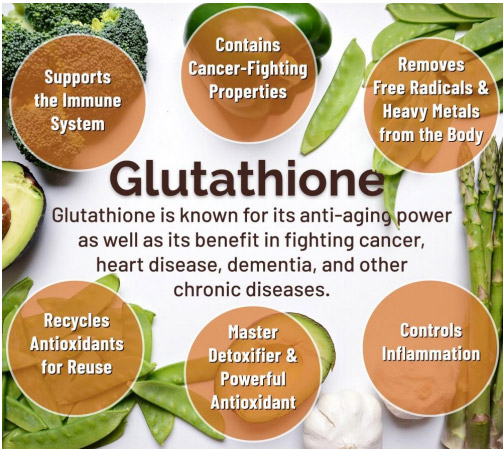NAC (N-acetylcysteine), glycine and glutathione form a very core biochemical combination. Understanding them means grasping the key to the human antioxidant system.
The core concept is that NAC and glycine are the “raw materials” for manufacturing glutathione.
Core role: Glutathione
Glutathione is the “ultimate protagonist” of this discussion.
What is glutathione?
Glutathione is a tripeptide composed of three amino acids – glutamic acid, cysteine and glycine. It is the most important and powerful endogenous antioxidant in the human body and is known as the “mother of Antioxidants”.
Where is glutathione?
It exists in every cell of the body, especially at a very high concentration in the liver.
core functions of glutathione:
- Direct antioxidation: Neutralize free radicals and protect cells from oxidative damage.
- Regenerating other antioxidants: It can “regenerate” antioxidants such as vitamin C and vitamin E, restore their activity, and thereby amplify the effect of the entire antioxidant network.
- Liver detoxification: It is a key substance in the liver’s Phase II detoxification pathway, capable of combining with toxins, heavy metals, and by-products of drug metabolism, causing them to dissolve in water and be excreted from the body.
- Immune regulation: Supports the function of immune cells and optimizes immune responses.
- Cellular energy metabolism: Participates in the energy production of mitochondria.
With age, stress, illness, poor diet and environmental pollution, the level of glutathione in the body will decline, leading to an increase in oxidative stress, which is associated with aging and many chronic diseases.
role of raw materials: NAC and glycine
The body needs raw materials to synthesize sufficient glutathione.
Among these three raw materials, cysteine, due to the instability of the sulfhydryl group (-SH) in its molecular structure and its relatively low content in daily diets, usually becomes the “rate-limiting factor” for the synthesis of glutathione – that is to say, its supply directly determines the output of glutathione.
This is the reason why NAC and glycine come into play.
NAC: Provides crucial “rate-limiting” raw materials
What is NAC?
N-acetylcysteine is the stable and more bioavailable precursor form of the amino acid cysteine.
core role of NAC:
Direct supplementation of raw materials for glutathione synthesis:
After oral administration of NAC, it is converted into cysteine in the body, greatly increasing the supply of the key, rate-limiting raw material required for the synthesis of glutathione.
Powerful expectorant
It can break the disulfide bonds in mucus and dilute phlegm.
Antidote for acetaminophen poisoning:
In hospitals, it is the standard antidote for liver damage caused by an overdose of acetaminophen (paracetamol) through replenishing glutathione stores.

Glycine: Provides essential “supporting” raw materials
What is glycine?
It is one of the simplest non-essential amino acids.
The core function of glycine:
Essential raw materials for synthesizing glutathione:
Without glycine, even if there is a large amount of cysteine, glutathione cannot be synthesized.
The research found:
Modern diets and lifestyles may lead to “functional glycine deficiency” in some people.
Studies show that supplementing NAC alone is sometimes ineffective because glycine may become a new “limiting factor”.
Supplementing NAC and glycine simultaneously can more effectively increase the level of glutathione in the body.
Other benefits:
It is an inhibitory neurotransmitter that can improve sleep. It is also a major component for synthesizing collagen and is beneficial to skin and joint health.
Should glutathione directly supplemented or should raw materials supplemented?
This is a very common problem. Both methods have their advantages and disadvantages:
Direct supplementation of glutathione (oral or liposome)
Advantages: Direct and convenient.
Challenge: Traditional glutathione supplements are broken down by enzymes in the digestive tract, and their bioavailability has always been an issue.
Current situation: In recent years, the emergence of reduced glutathione and liposome glutathione technologies has significantly increased the oral absorption rate and become more effective.
It is a great choice for those who need to improve their skills quickly or have weak digestive functions.
Supplement raw materials (NAC + glycine)
Advantages
More economical: Usually cheaper than glutathione products with high bioavailability.
“Production on demand” : The body can synthesize glutathione at the right time and place according to its own needs, with more precise regulation.
Synergistic effect: NAC and glycine each have other independent health benefits (such as the expectorant effect of NAC and the sleep-aiding effect of glycine).
Disadvantage: It requires the body to carry out the synthesis step, and for individuals with severely impaired synthetic functions, the efficiency may be slightly lower.
Conclusion
For most people, supplementing NAC and glycine is a very effective and cost-effective strategy to increase glutathione levels.
Directly supplementing with highly bioavailable glutathione is also an effective option, especially suitable for those who seek convenience and quick results.
Suggestions for combined use
Objective
Synergistically increase glutathione levels to enhance antioxidant and detoxification capabilities.
Applicable population
- Pay attention to anti-aging and anti-oxidation.
- Those who frequently drink alcohol and are exposed to environmental pollution.
- Those with liver health issues or who wish to support detoxification.
- People with weakened immunity and chronic fatigue.
- Those who wish to receive support for mental health (oxidative stress is related to anxiety and depression).
Common dosage (as a reference for dietary supplements) :
NAC: 600mg – 1800mg daily, taken in divided doses (such as 600-900mg in the morning and evening). Taking it on an empty stomach may lead to better absorption.
② Glycine: 1000mg – 3000mg daily. If it is used to improve sleep, take 3 to 5 grams alone before going to bed.
③ Direct supplementation of glutathione: If chosen, take 250mg – 500mg of liposomes or reduced glutathione daily.
④ Usage example:
Plan A (Raw Materials Plan) :
Take 600mg of NAC and 1000mg of glycine in the morning. Take 600mg of NAC and 2000mg of glycine one hour before going to bed at night (taking advantage of the sleep-inducing effect of glycine).
Option B (Hybrid Option)
Take 500mg of liposomal glutathione in the morning. Take 600mg of NAC and 1000mg of glycine at night.
About GSH Bio-Tech

